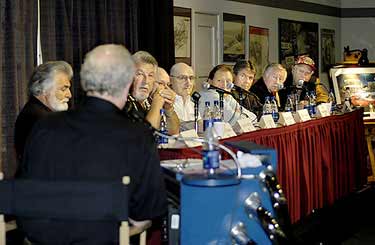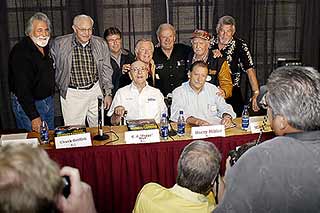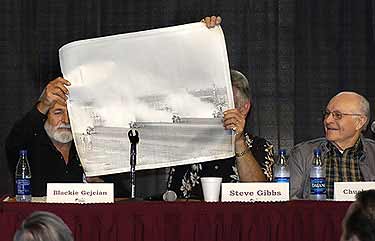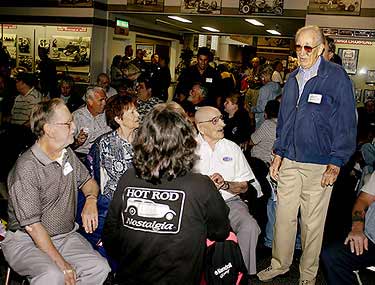
5/7/04
“Outlaw” Operators Hosted By Wally Parks And His Museum
 Moderator Dave McClelland (back to camera) introduced celebrity-panelists Blackie (“Call Me Whitey!”) Gejeian, Steve Gibbs, Chuck Griffith, C.J. Hart, Harry Hibler, Mike Jones, Don Rackemann and Lou Senter. Partially visible at far right is James Ibusuki’s original painting of “The Manufactuers Final”, a lithograph (available from hotrodnostalgia.com) celebrating Jones’s best-remembered OCIR event. (Photo by Chris Ouellette/Good Communications) |
![]() y favorite NHRA
events are presented by the “guerilla wing of the organization, i.e., the
small staff of the Wally Parks Motorsports Museum. Located on the grounds of
the L.A. Fairplex, mere minutes from corporate headquarters, the museum is operated
as if it’s on a different planet. That’s not a bad thing. While the
historically-challenged outsiders in charge of the parent company continue to
come up with innovative ways to drive off NHRA’s oldest, hardest-core racers
and fans, the savvy museum crew conceives nostalgia-flavored shows that appeal
to us “lost souls.”
y favorite NHRA
events are presented by the “guerilla wing of the organization, i.e., the
small staff of the Wally Parks Motorsports Museum. Located on the grounds of
the L.A. Fairplex, mere minutes from corporate headquarters, the museum is operated
as if it’s on a different planet. That’s not a bad thing. While the
historically-challenged outsiders in charge of the parent company continue to
come up with innovative ways to drive off NHRA’s oldest, hardest-core racers
and fans, the savvy museum crew conceives nostalgia-flavored shows that appeal
to us “lost souls.”
The first such success was the NHRA California Hot Rod Reunion at Bakersfield, the brainchild of museum staffers Steve Gibbs and Greg Sharp. In 12 years, its attendance has grown to rival that of some NHRA national events. Another example is the year-old National Hot Rod Reunion, an immediate sensation in Bowling Green, Ky. Not coincidentally, both shows are staged at distinctive, decades-old drag strips, which in no way resemble the sterile, concrete-and-aluminum “’plexes” that pollute the championship circuit.
|
|
Lesser known, but no less significant, is a series of indoor presentations hosted at the museum itself. So irresistible was the latest such promotion that I found myself driving all night—more than 400 miles—to make a 10 a.m. gathering of former California track operators, appropriately billed as “Drag Strips We Knew And Loved (And The Men Who Ran Them)”. As the sun came up beside Highway 99, I was reminded of countless early-morning trips to the same Pomona property in the 1960s, ‘70s, ‘80s and early ‘90s, when I wouldn’t have dreamed of missing opening day of a Winternationals or World Finals. Sadly, those days are long gone for me.
Irony was everywhere, beginning with a familiar approach that took my dad and me along the full length of the Pomona track, on a road that was once recognizable to anyone who ever saw a top-end photo. Alas, those towering cypress trees behind every parachute shot have been harvested to make room for more concrete. Upon arrival at the museum, more irony was supplied by the odd combination of panelists: former track operators traditionally aligned with, and invariably opposed to, the sanctioning body and its edicts. In a program both hosted and promoted by NHRA, the panel leaned heavily towards the latter, “outlaw” element.
 The media turned out in force to document an unprecedented gathering of greats: (L-R) Blackie Gejeian, Chuck Griffith, Mike Jones, C.J. Hart, Don Rackemann, moderator Dave McClelland, Harry Hibler, Lou Senter, Steve Gibbs. (Photo by Chris Ouellette/Good Communications) |
In stark contrast to Pomona’s original track manager, Chuck Griffith, and longtime-NHRA-official Gibbs sat legendary pains-in-the-ass Louie Senter (Saugus), Harry Hibler (San Fernando), Blackie Gegeian (Fresno), and Don Rackemann (Fontana, Riverside). All operated one or more outlaw strips that proudly violated NHRA policy on a weekly basis.
Rackemann, who started out as the Saugus starter in 1951, also did time as a “chicken-blower” (i.e., advertising salesman) for and publisher of Drag News, the 1955-78 tabloid that was more critical of NHRA policies and Wally Parks, personally, than any other publication—and was more successful than National Dragster into the 1970s. To this day, more than a quarter-century after the newspaper’s demise under Rackemann’s mismanagement, Parks has neither forgotten nor forgiven Drag News (unless it’s mere coincidence that Wally’s private e-mail address, spelled backwards, reads “dragnewskrap”). More irony: Parks himself was in the audience, and ultimately made an unscheduled trip to the podium—to reinforce his oft-stated contention that the infamous Fuel Ban was initiated not by NHRA, but by a group of southern California drag strips. The audience was respectful, if seemingly unconvinced.
 Two decades of infamous Blackie Gejeian promotions included four-abreast AA/FD match races at his ultrawide Fresno, Calif., facility. Here, Steve Gibbs helps unfurl photographic proof. (Photo by Chris Ouellette/Good Communications) |
Gejeian’s two decades of innovative promotions included four-abreast matches of fuel dragsters and jet cars. Obviously suspecting that the subject would come up, Blackie brought along a black-and-white enlargement of four mid-Sixties fuelers blasting off, which he unfurled to great applause. He also recalled Fresno’s first “car-burning” (courtesy of jet-jockey Doug Rose), which resulted in damage to an entire fleet of school buses parked adjacent to his track.
 A question-and-answer segment and autograph session extended the event well beyond its scheduled conclusion. Visible at the edge of the speakers’ platform are copies of Bob McClurg’s new CarTech history book, which were presented to the panelists (and went on sale at the museum).(Photo by Chris Ouellette/Good Communications) |
What sent the Applause-O-Meter right off the deep end was C.J. Hart’s introduction. Days shy of his 93rd birthday, the founder of the first commercial drag strip (Santa Ana) and manager of the best one (Lions) went on to crack up the crowd with answers to questions from moderator Dave McClelland, his fellow panelists, and audience members. “Pappy” also contributed the most-emotional moments when he thanked everyone in the room for making him feel so special, and paid tribute to his late wife and partner, Peggy.
 The Wally Parks Motorsports Museum was packed with celebrities; none bigger than the man whose name is on the building. Shown visiting with NHRA’s founding father are (L-R) Dave Wallace Sr.; Joanie Hart (C.J.’s daughter); Dave Wallace Jr.; Pappy Hart. More than 120 people paid $20 for the presentation and lunch. (Photo by Chris Ouellette/Good Communications) |
Mike Jones, who came out of nowhere to create Orange County International Raceway in 1966-67 -- then returned to obscurity six years later—entertained with stories of rival- promoters Hart and Gibbs (then running Irwindale) playing tricks on the young newcomer. Jones also confided that construction of OCIR consumed approximately $750,000, an unheard-of amount at the time.
|
|
NHRA events are typically all too easy to criticize, but the only shortcoming
of this one was its short duration—a situation made worse by McClelland,
who chewed up valuable time telling stories of his own track-management escapades
in Texas and Louisiana. (Yawn.) Mac’s unquestionable announcing talent
is welcomed by almost any audience, but his annoying inclination to insert himself
into the show played poorly with this discriminating crowd. Call us a bunch
of SoCal snobs, but everyone else in attendance realized that our part of the
planet was the center of the universe from 1950 through 1970, and couldn’t
care less about how they were doing it elsewhere.![]()
 |
||
Copyright 1999-2004, Drag Racing Online and Racing Net Source